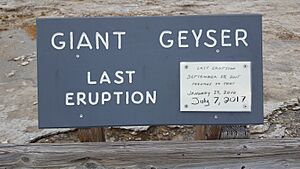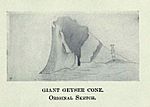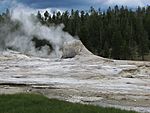Giant Geyser facts for kids
Quick facts for kids Giant Geyser |
|
|---|---|
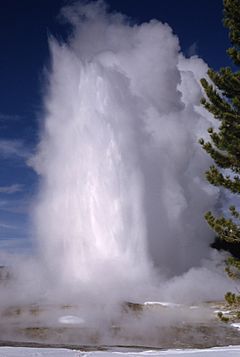
Giant geyser eruption 1952
|
|
| Name origin | Named by the Washburn-Langford-Doane Expedition on September 18, 1870 |
| Location | Upper Geyser Basin, Yellowstone National Park, Teton County, Wyoming |
| Coordinates | 44°28′15″N 110°50′27″W / 44.4707661°N 110.8407669°W |
| Elevation | 7,323 feet (2,232 m) |
| Type | Cone geyser |
| Eruption height | 250 feet (76 m) |
| Frequency | variable days to weeks |
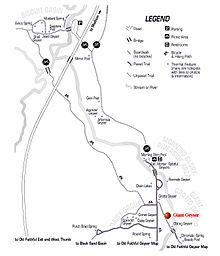
Northern section of Upper Geyser Basin
|
|
Giant Geyser is a very tall geyser found in the Upper Geyser Basin of Yellowstone National Park in the United States. It's known for its amazing, but not very often, eruptions. Giant Geyser also has a really big cone made of rock, which is about 12 feet (3.6 meters) tall!
Giant Geyser is the main geyser in a group called the Giant Group. This group includes other geysers like Bijou Geyser, Catfish Geyser, and Mastiff Geyser. All these geysers are located on a raised stone platform.
Contents
History of Giant Geyser
On September 18, 1870, a group of explorers called the Washburn–Langford–Doane Expedition visited the Upper Geyser Basin. They saw many geysers erupting. During their trip, they named seven geysers, and one of them was Giant.
First Descriptions of Giant Geyser
Nathaniel P. Langford, one of the explorers, wrote about the Giant Geyser in 1871. He described it as having a rough opening about ten feet wide. He said that when it erupted, a huge amount of water shot up.
Langford saw the Giant Geyser erupt only once. He said the water column was five feet wide and went up 140 feet (43 meters) high. This eruption lasted for almost three hours without stopping. He also mentioned that the geyser's opening looked like a tiny model of the Coliseum.
Giant Geyser Eruptions
Giant Geyser can go for a long time without erupting. Its activity changes a lot from year to year. For example, it was quiet for several years starting in 1955. From 1963 to 1987, it only erupted six times!
Recent Eruption Patterns
Around 1997, the geyser erupted more often, sometimes every four days. A very active period for Giant Geyser started on August 6, 2005. It continued until April 29, 2008, when it became much less active. There was one more eruption on August 26, 2008.
- In 2005, there were 11 eruptions.
- In 2006, there were 47 eruptions.
- In 2007, there were 54 eruptions, which was the most since 1955.
- In 2008, there were 13 eruptions.
After that, there were no recorded eruptions in 2009, and only two in January 2010. Giant Geyser erupted on September 28, 2015, and most recently on March 10, 2019. After this, it became quiet again. Scientists don't know why its activity changes so much.
Understanding Eruptions
Even when Giant Geyser is not erupting, it still steams and splashes. But eruptions only happen during "hot periods." During these times, other springs on the Giant Platform also become more active, and Giant itself splashes more intensely.
Hot periods usually last a few minutes. Most of them do not lead to an eruption. When a hot period ends, the activity goes back to normal. It might be tens of minutes or even hours before the next hot period. When Giant Geyser does erupt, it's very dramatic! The eruption can last about an hour and sometimes shoot water over 250 feet (76 meters) high.
Eruption Count by Year
| Year | Number of eruptions |
|---|---|
| 2006 | 47 |
| 2007 | 54 |
| 2008 | 10-20 |
| 2009 | 1? |
| 2010 | 2 |
| 2011 | 0 |
| 2012 | 0 |
| 2013 | 0 |
| 2014 | 0 |
| 2015 | 1 |
| 2016 | 0 |
| 2017 | 3 |
| 2018 | 28 |
| 2019 | 8 |
Images for kids


